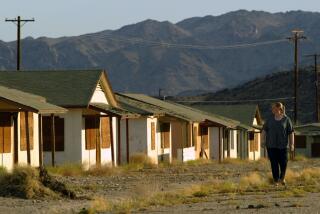Pete Seibert, 77; Founded Popular Ski Resort That Draws Millions to Vail
- Share via
Pete Seibert, who founded the nation’s largest and most popular ski hill, Vail Mountain, died Monday of cancer in Vail, Colo. He was 77.
Although a relative newcomer to the ski scene, the Vail resort exploded in size and popularity after opening in 1962. The ski area today covers 5,200 acres, has 33 chairlifts and drew 1.5 million skiers last season, despite less than ideal snow conditions across the West.
“He’s the father of Vail,” said Ludwig Kurz, the town’s mayor and a longtime friend of Seibert. “He had a tremendous impact on Vail and the Vail Valley and, really, the U.S. ski industry. He set standards that were higher than had ever been thought of before.”
Born in 1924 in New Hampshire, Seibert recognized early on that skiing was his future. As he told the story, at age 12 he opened a ski book and saw a photo of a quaint Austrian resort. From that moment forward, Seibert said, “there was nothing I wanted more in my life than to start a ski area.”
But first came World War II. Because he was talented on skis, Seibert was recruited to join the Army’s 10th Mountain Division.
The unit had been formed in 1941 when the head of the National Ski Patrol convinced the Army that the military was thoroughly unprepared to go to battle in the mountains of Europe--and that it was easier to make soldiers out of skiers than vice versa.
Some veterans would later joke that the training was worse than the war. Based at Camp Hale in the Colorado Rockies, Seibert and hundreds of others endured “d-series training,” during which the unit spent weeks above 10,000 feet in winter, skiing many miles each day carrying 90-pound packs.
The actual war featured its own set of horrors. The 10th Mountain Division was charged with driving the Germans from the Alps. Seibert was hit by mortar fire in the Appenine Mountains of northern Italy, and his right kneecap was badly damaged. When he was evacuated from the front lines--after three days--doctors said he would never again walk.
Two years later, Seibert was a ski instructor in Aspen.
The decade after the war was a heady time for the nation’s fledgling ski industry. Businessmen, dreamers and ski bums were scouring the West for places to build resorts, convinced that the sport would soon boom in popularity. Veterans of the 10th Mountain Division were often involved, because they were among the most talented skiers in the nation.
After a stint learning the hotel business in Switzerland in the early 1950s, courtesy of the G.I. Bill, Seibert returned to Colorado. While managing the Loveland ski area near Denver, he and his friend Earl Eaton began looking for their own ski hill.
Eaton had grown up in Colorado and knew about a “no name” mountain near Vail Pass. After a seven-hour slog to the summit in the late 1950s, the two peered down into the mountain’s enormous, wide-open back bowls and knew they were looking at a skier’s paradise.
Investors were quickly rounded up, and a sheep farm at the mountain’s base was purchased. To mask their intentions from other ski developers, Seibert and Eaton called the place a rod-and-gun club. There was no real town, and only one phone in the area, which was connected to distant Denver by a two-lane highway.
Soon after the resort opened, it gained a reputation for its friendly terrain. Much to the chagrin of other Western resort owners, Vail’s marketers proved brilliant at using the burgeoning airline industry to lure people from across the globe to town. Soon, Interstate 70 was built, bringing even more skiers with it.
Then disaster struck. In March 1976, a frayed cable caused two gondolas carrying skiers up the mountain to plunge 125 feet to the ground. Four were killed and eight injured.
Fearing the inevitable lawsuits, Seibert sold his stake in the resort, and Vail changed hands several times. Vail Resorts is now a publicly traded company and owns several other resorts, including Breckenridge, Keystone and Beaver Creek in Colorado, Grand Teton Lodging Co. in Wyoming and Heavenly in California.
In the years since Seibert left, Vail has increasingly been portrayed by the national media as a sort of two-headed monster. The skiing is almost universally praised as great. But the resort has been roundly criticized for encouraging a sprawl of million-dollar homes in the surrounding area. In 1998, arsonists--apparently upset at yet another expansion of ski terrain--torched several of the resort’s buildings and chairlifts. No one was ever arrested.
Seibert went on to help start several other resorts in the West, including Snowbasin in Utah’s Wasatch Mountains. He also eventually returned to work for Vail as a consultant and vigorously pursued his passions--golf and skiing.
“He was a skier at heart, and he thought that everything that happened here was maybe a little more than what he envisioned,” said Kurz. “But he never commented to me whether it was good or bad; that’s just the way it was.”
He is survived by three sons and five grandchildren.
Funeral services are pending.
More to Read
Sign up for Essential California
The most important California stories and recommendations in your inbox every morning.
You may occasionally receive promotional content from the Los Angeles Times.










